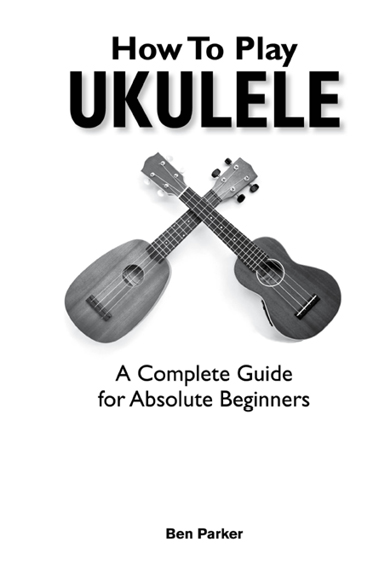
Author: Ben Parker
Edited by: Alison McNicol
First published in 2012 by Kyle Craig Publishing
Text and illustration copyright 2012 Kyle Craig Publishing
Design and illustration: Julie Anson @ The Great Little Design Co.
Music set by Ben Parker using Sibelius software
ISBN: 978 -1-908-707-08-6
A CIP record for this book is available from the British Library.
A Kyle Craig Publication
www.kyle-craig.com
All Rights Reserved.
No part of this publication may be reproduced, stored in a retrieval system or transmitted by any form or by any means, electronic, recording or otherwise without the prior permission in writing from the publishers.
Unauthorised reproduction of any part of this publication by any means including photocopying is an infringement of copyright.
 Introduction
Introduction
Welcome to How To Play The Ukulele . The ukulele is slowly becoming the most popular instrument for children and adults who wish to start playing a string instrument. Its size and simplicity (it only has 4 strings!) makes it an easier instrument to get to grips with quickly and many beginners are playing their first chord within minutes. In this book we aim to give you your first simple steps to playing which can act as a basis for a bright future with the instrument. Also included in the book is a step by step guide to reading music .
The ukulele is also fun to learn in groups or as a parent/child activity. Ukulele groups are springing up all over the country and the sound of a group of ukuleles playing is incredibly inspiring!

 Practice
Practice
Like any skill, playing an instrument takes a lot of practice. Practicing more regularly for shorter lengths of time is more effective than practicing for an hour or so just once a week. The minimum amount would be around 15-20 minutes , 3 to 4 times a week. The ideal amount would be 20 minutes a day, 7 days a week. Maybe set out a plan of your week and work out the best times to fit your practicing around the other things you do. The more your practice can become part of your weekly or daily routine the better.

 About The Ukulele
About The Ukulele
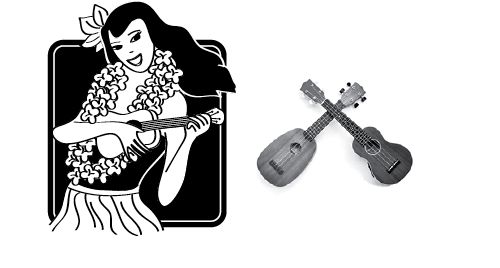
The Ukulele originates from Hawaii and is an adaptation of string instruments brought to the island by Portuguese immigrants in the late 1800s. It comes in four different sizes: soprano, concert, tenor and baritone . The most common beginners instrument is the soprano ukulele. The ukulele is similar to the guitar you can play both chords and single notes, strum and pick. These different ways f playing make it an interesting instrument to learn, with different stages of ability as your skills progress.
 The Instrument
The Instrument
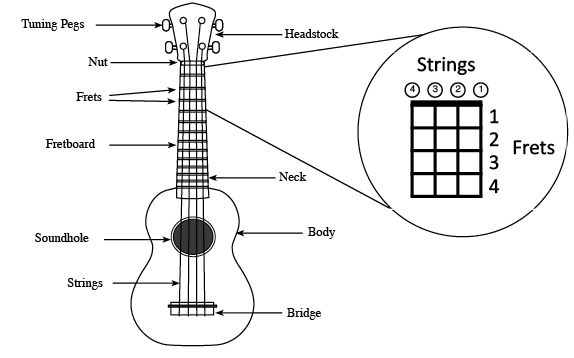
 How To Hold The Ukulele
How To Hold The Ukulele
Because the ukulele is such a light instrument you can hold it between your right forearm and your body. Hold it in place by pushing it gently against the bottom of your ribcage. This works for both a seated and a standing playing position. You can then strum from the wrist so your forearm can keep the ukulele close to your body.
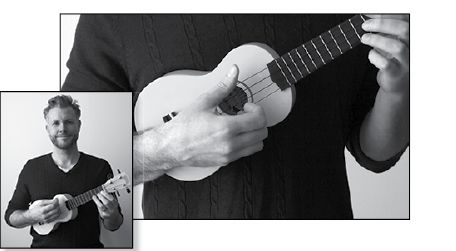
 What To Do With Your Hands
What To Do With Your Hands
LEFT HAND POSITION
Your left hand position is really important. Make sure your thumb is around the back of the neck. When you fret a note it should be like pinching the neck between your thumb and fretting finger. Fretting will be explained in more detail later on in the book.
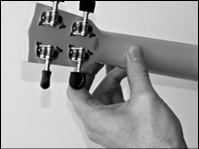
LEFT HANDED PLAYERS
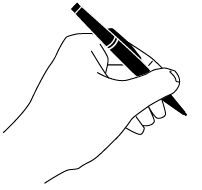 Some left handed players play the ukulele right-handed. If you are left-handed try the playing position shown and see how it feels. If it feels strange, try playing it the other way round (with the ukulele headstock pointing to your right) if this position feels more comfortable then youll need to have the ukulele re-strung upside down. Ask at your local music store they should be able to do this for you.
Some left handed players play the ukulele right-handed. If you are left-handed try the playing position shown and see how it feels. If it feels strange, try playing it the other way round (with the ukulele headstock pointing to your right) if this position feels more comfortable then youll need to have the ukulele re-strung upside down. Ask at your local music store they should be able to do this for you.
 Using A Plectrum / Pick
Using A Plectrum / Pick
You can use your right hand fingers to play a ukulele but many players use a plectrum (often called a pick) to strum chords and pick single notes. It is best to strum across the strings where the neck joins the body of the ukulele. This produces a bright sound. If strumming with your fingers (without a pick) use your thumb to strum downwards and your index finger for the upstroke.
Picks come in different thicknesses. A pick of medium thickness (nylon .60mm) is probably the best place to start. A brighter tone can be produced with a pick and most players find it easier to move swiftly between playing chords and single notes when using one. There will also be more about picking the strings with your right hand fingers later on in the book.
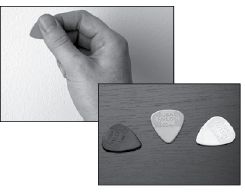
 Tuning
Tuning
The strings of the ukulele are tuned to the notes G , C , E & A . These strings are known as the open strings. Pressing down on a string with a left hand finger to change the pitch of the note is called fretting. Unlike most other fretted string instruments the string closest to you as you look down at the ukulele in playing position is NOT the lowest in pitch. This peculiar string layout is what gives the ukulele its distinctive sound. The strings are also numbered to help us when referring to them.
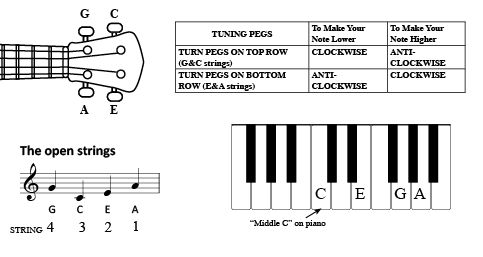

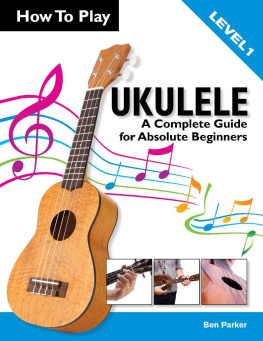







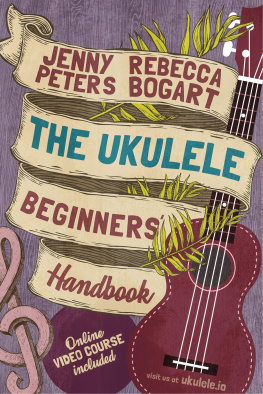
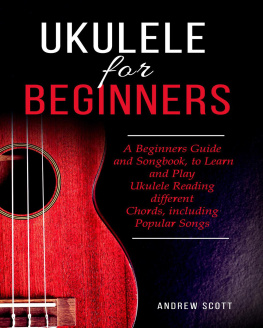

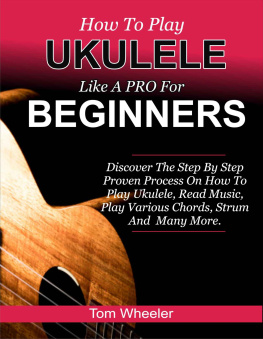


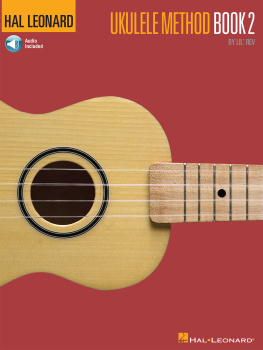
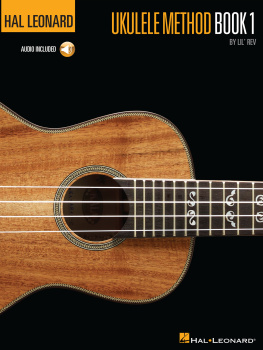


 Introduction
Introduction
 Practice
Practice
 About The Ukulele
About The Ukulele
 The Instrument
The Instrument
 How To Hold The Ukulele
How To Hold The Ukulele
 What To Do With Your Hands
What To Do With Your Hands
 Some left handed players play the ukulele right-handed. If you are left-handed try the playing position shown and see how it feels. If it feels strange, try playing it the other way round (with the ukulele headstock pointing to your right) if this position feels more comfortable then youll need to have the ukulele re-strung upside down. Ask at your local music store they should be able to do this for you.
Some left handed players play the ukulele right-handed. If you are left-handed try the playing position shown and see how it feels. If it feels strange, try playing it the other way round (with the ukulele headstock pointing to your right) if this position feels more comfortable then youll need to have the ukulele re-strung upside down. Ask at your local music store they should be able to do this for you. Using A Plectrum / Pick
Using A Plectrum / Pick
 Tuning
Tuning